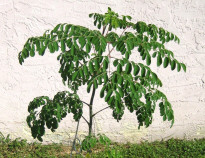I Love Moringa
the fast-growing, nutritious, delicious gift from God
If you love salad greens, spinach, collards, and other greens, you will LOVE moringa! Right off the tree, it almost has a spinach-watercress taste. Steamed, or sautéed with a touch of butter, olive oil or coconut oil, it almost tastes like "pecan" spinach. It is tender, delicious, and highly nutritious. It is also one FAST growing tree! Some Moringa trees are slender, some have "bottle trunks", some are tuberous. All of them are beneficial.
A few years ago, I was introduced to Moringa. With the exorbitant cost of fresh food at the grocery stores and supermarkets, we decided to plant as much in the way of edible landscaping as we could. Planting Moringa was essential. It is an incredible
powerhouse of fresh nutrition.
In the center, above is a photo of the top of one of my Moringa trees. It is about 4' tall, at only a few months old. Already, we have picked and eaten a lot of the leaves. Moringa
can be grown in your yard, in your garden, as a windbreak, as a hedge, or in a
container - inside or out. It is basically a tropical tree, so it loves water, sunlight, and warmth. Moringa Oleifera is one of the fastest-growing biomasses on the planet - easy to grow, and wonderful to eat.
We recommend that you eat the leaves - fresh, cooked, or dried, the flowers - cooked, the young pods - cooked, and the seeds - cooked. Moringa seeds, crushed into powder, can be used to purify water. The ROOT - which tastes like horseradish - LEAVE ALONE . The root bark contains a substance that can be extremely toxic to your nervous system. Too much of it can harm you. How much? No one seems to know. Our advice is - don't eat it!
Moringa Varieties:
arborea, borziana, concanensis,
drouhardii,
hildebrandtii,
longituba, oleifera, ovalifolia, peregrina, pygmaea, rivae,
ruspoliana,
stenopetala.
Most people are
familiar with only 2 varieties. Both are extremely nutritious
and also, delicious.
Moringa Oleifera
is by far the most
common. It is a
slender tree, which
can be planted as a windbreak or a hedge.
Moringa Stenopetala
which is also called African Moringa,
is the second most commonly grown
variety. It develops
a "swollen" trunk,
called a bottle trunk
which stores water.
There are photos of both varieties,
< CLICK ON THE SMALL PHOTOS TO ENLARGE THEM >
HOW TO:
Moringa is
also called:
Drumstick Tree
Horseradish Tree
Ben Oil Tree
The Miracle Tree
Benzolive Tree
Malunggay
Ma Rum
Marungay
Kelor,
among others.
Worldwide, Moringa is known
by many names.
No matter what you call it,
Moringa is one
valuable tree.
Rarely can you plant anything that grows so fast, and packs so much nutrition in it, as the humble Moringa tree.
With one encounter, it is "love at first site" or "love at first bite".
MORINGA - THE MIRACLE TREE!
Considered by some to be the "Tree of Life"!
(Ok, it isn't, but you'll come to think it is...)
SUPER NUTRITION - right in your own backyard!
More About --- Moringa
This page was last updated: September 6, 2022

